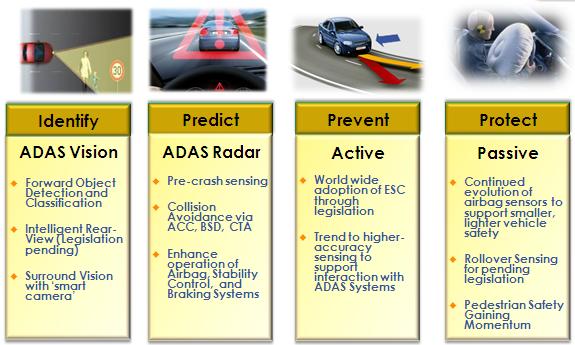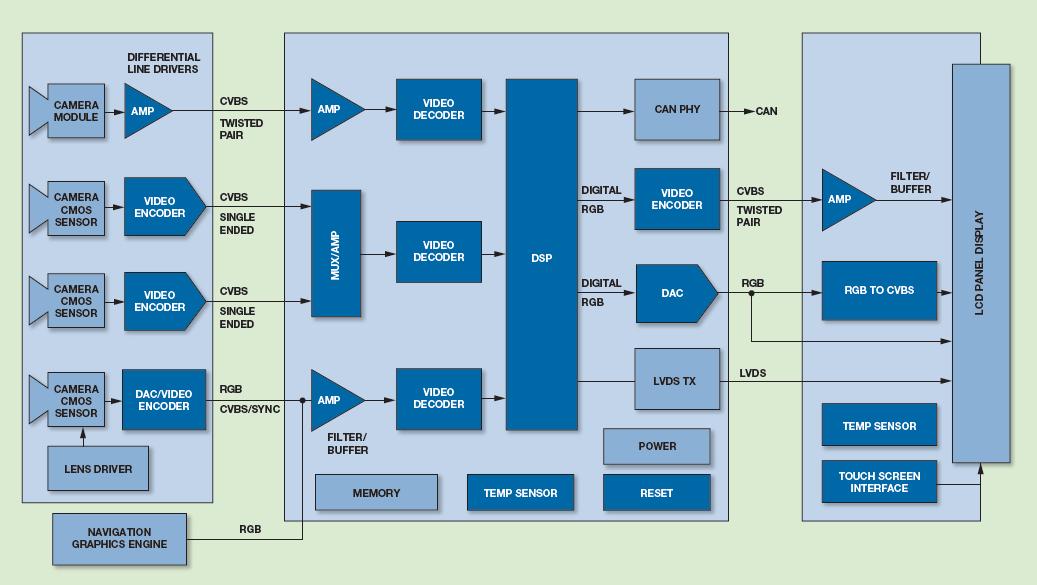With the rapid development of the mid-to-high-end automotive market and the substantial increase in the safety awareness of governments and people in various countries, the advanced driver assistance system (ADAS) technology that once served the niche high-end market has gained rapid development momentum, especially with the The cost of platforms and solutions has fallen, and the deployment of ADAS applications and sensing platforms has rapidly penetrated from high-end cars to mid-range and even entry-level car models. For automotive OEMs, after passive safety systems and infotainment equipment, ABS, ESP, etc. have become the current standard equipment for automotive electronics, advanced active safety systems such as ADAS can also serve as value-added highlights of product differentiation.
According to IHS isuppli's auto research special report, in 2011, the total revenue of the three major ADAS technologies such as adaptive cruise control system (ACC), lane departure warning (LDW) and side object detection (SOD) reached 1.65 billion US dollars, compared with 2010 Year-on-year increase of 57%. In 2012, the growth momentum is even stronger, and the total operating income will increase to 2.69 billion US dollars, an increase of up to 63%.
"In the application of automotive safety technology as shown in Figure 1, the ADAS system can be used from recognition, prediction, to prevention, which can greatly improve vehicle safety and prevent accidents, and can also increase driving comfort. Li Fangzhen, senior manager of automotive electronics in ADI's Greater China region, said, "ADI is optimistic about the prospects of ADAS in the global and Chinese automotive markets. It has set up a solution R & D team in India and has developed a series of ADAS reference design solutions. And the underlying algorithm, and through the domestic third-party company for secondary development, can be provided to customers for free, reducing costs while helping customers significantly shorten the design cycle. "

Figure 1 Four links in the field of automotive safety technology applications
Requirements for signal processing based on vision-based ADAS
As mentioned above, the lane departure warning (LDW) technology, one of the three mainstream applications of ADAS, can monitor the lateral movement of the car in the lane, and warns the driver when the car may exceed the lane line. This system technology is a concrete realization of the vision (camera) ADAS system.
In fact, vision-based ADAS can greatly improve driving safety in many ways by playing the role of camera recognition. By installing a rear view / front view / side view camera and a vision processing ECU, a variety of functions can be implemented to help the driver prevent risks in advance. According to the research report, 70% of cars currently have a rear-view function, and 30% of high-end cars have a front-view function. By 2015, this proportion is expected to reach 60%. Therefore, vision-based ADAS will be better than radar-based ADAS systems ( Focus more on target detection) to spread more quickly in the low-end automotive market.
"Currently popular applications include lane departure warning (LDW), high beam and low beam adjustment (HB / LB), traffic sign recognition (TSR), pedestrian detection (PD), parking assistance, rear view / surrounding, and collision warning However, due to different models or understanding of the market, the functional positioning of the visual ADAS application system of different automotive OEM manufacturers is somewhat different, so the requirements for the digital signal processing chip platform specifications will also be somewhat different. "ADI's Li Fangzhen said.

Figure 2 Main signal chain of vision-based ADAS system
Figure 2 shows the main signal chain of the vision-based ADAS system, mainly including analog video transmission, encoding, transmission, decoding, processing and display. Li Zhenzhen analyzed: "As the camera resolution tends to be higher and higher, the number is increasing, and the number of functions of each system is increasing. All these trends have increased the performance requirements of DSP devices. At the same time, The signal processing power consumption cost ratio is more stringent. "
Processors and free design resources specifically for ADAS applications
Faced with these trends and needs, ADI currently provides Blackfin processor series and mature and reliable high-performance video processing solutions specifically for ADAS applications, suitable for a variety of vision-based ADAS systems from single function to multi-function. In order to meet the needs of different automotive OEM customers, ADI provides different product selections in terms of processing speed (ranging from 400MHz to 1GHz), memory, interface, etc. In addition, ADI also provides a variety of main signal chain components such as video decoders / encoders, video multiplexers / switches, and video amplifiers with a variety of excellent performance.
In the global market, major automotive suppliers and OEMs are using ADI's leading high-performance signal processing technology to implement and deploy various radar and vision-based ADAS systems on passenger cars. It is reported that in the Chinese market, several manufacturers have developed development projects based on vision-based ADAS systems such as route deviation warning, traffic sign recognition, intelligent headlight control, object detection / classification, and pedestrian detection. However, radar-based ADAS The system (can also provide front / rear parking assistance, safe distance warning, lane change assistance, blind spot detection, adaptive cruise and other functions) is rarely followed up.
Li Fangzheng revealed that the Blackfin models commonly selected by Chinese ADAS development customers are ADSP-BF561, ADSP-BF549 or ADSP-BF534. These products comply with the ASIL (Automotive Safety Integrity Level) specification defined by the ISO 26262 standard and support the automotive safety concept. The optimized Blackfin compiler and image processing toolbox (ITB) low-level algorithm library developed by the ADI special team can maximize operating efficiency and MIPS. The software-based architecture helps users launch unique products.
Among them, ITB contains a complete set of image processing codes in the form of software modules, compatible with MISRA-C, optimized for Blackfin processors. ITB product functions include: color conversion; image filters, such as convolution, Sobel, and correlation; morphological operations, such as erosion and dilation; matrix operations; image filters; linear algebra; estimators, such as Kalman Filters, etc .; pyramids; ADAS modules, such as Hough transform, 2D integral image, and fish-eye correction.
In addition, ADI provides design resources including ADSP-BF53x / ADSP-BF54x / ADSP-BF561 evaluation board EZ-KIT Lite; Blackfin DSP integrated development environment: Visual DSP ++ ® and CCES®; video decoder, encoder / DAC, video Evaluation boards for amplifiers, video multiplexers, etc. "The design resources such as the algorithm library source code and evaluation board can be provided to customers for free, which is a major advantage of the ADI ADAS solution. Competitive evaluation boards are charged, and the code will not be freely available." Li Shockproof indication.
The latest generation of dual-core, 1GHz Blackfin processors ADSP-BF608 and ADSP-BF609 recently introduced by ADI are optimized for embedded vision applications and are equipped with a high-performance "Pipeline Vision Processor (PVP)" Video analysis accelerator. PVP consists of a set of configurable hardware processing modules, designed to accelerate up to 5 parallel image algorithms to achieve extremely high analysis performance. These processors will be another ideal choice for future ADAS system applications.
Acrylic Anti Blue Light Filter
Acrylic Anti Blue Light Filter is a product category designed specifically to protect eye health. With the popularization of electronic devices and the increase in usage time, people's attention to blue light radiation is also increasing. Blue light comes from electronic device screens, LED lights, etc. Long term exposure to blue light may have adverse effects on the eyes, including Eye strain, dryness, vision loss and other problems. In order to solve this problem, acrylic anti blue light filters have emerged.
The acrylic anti blue light filter is made of high-quality acrylic material, which has excellent transparency and durability. It can effectively filter out harmful blue light emitted by electronic device screens, reducing the irritation and harm of blue light to the eyes. By using acrylic anti blue light filters, users can reduce eye fatigue, improve visual comfort, and improve work and learning efficiency.
The acrylic anti blue light filter has the characteristic of simple and easy installation, and users only need to place it on the screen of electronic devices. It is suitable for various electronic devices, such as computers, tablets, smartphones, etc. Whether at home, in the office, or on the go, users can use acrylic anti blue light filters anytime and anywhere, effectively protecting eye health.
In addition, the acrylic anti blue light filter also has functions of anti glare and protecting screen privacy. It can effectively reduce screen reflection and glare, providing a clearer and more comfortable visual experience. At the same time, acrylic anti blue light filters can effectively protect the content displayed on the screen from being peeped at by others, providing higher privacy protection.
Acrylic Anti Blue Light Filter,Blue Light Screen Protectors,Anti Blue Light Filter,Blue Light Filter For Pc
Guangdong Magic Electronic Limited , https://www.magicmax.cc